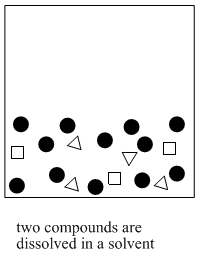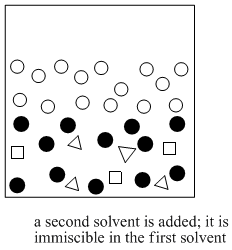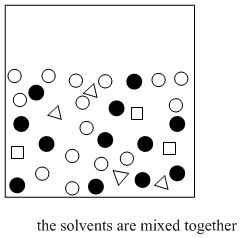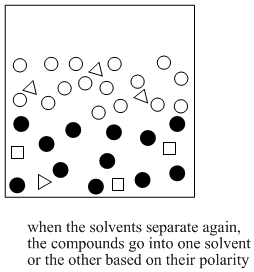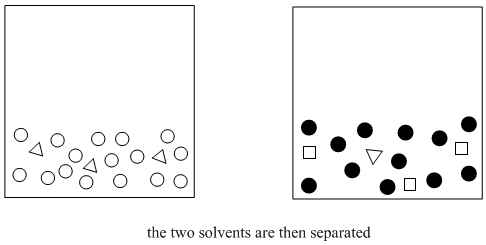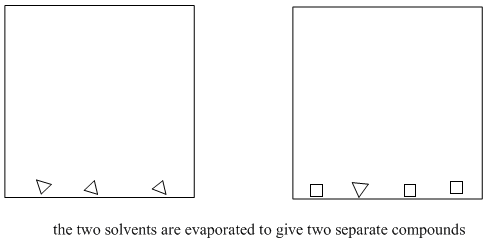Solvent Partitioning (Liquid - Liquid Extraction)
- Page ID
- 221850
\( \newcommand{\vecs}[1]{\overset { \scriptstyle \rightharpoonup} {\mathbf{#1}} } \)
\( \newcommand{\vecd}[1]{\overset{-\!-\!\rightharpoonup}{\vphantom{a}\smash {#1}}} \)
\( \newcommand{\id}{\mathrm{id}}\) \( \newcommand{\Span}{\mathrm{span}}\)
( \newcommand{\kernel}{\mathrm{null}\,}\) \( \newcommand{\range}{\mathrm{range}\,}\)
\( \newcommand{\RealPart}{\mathrm{Re}}\) \( \newcommand{\ImaginaryPart}{\mathrm{Im}}\)
\( \newcommand{\Argument}{\mathrm{Arg}}\) \( \newcommand{\norm}[1]{\| #1 \|}\)
\( \newcommand{\inner}[2]{\langle #1, #2 \rangle}\)
\( \newcommand{\Span}{\mathrm{span}}\)
\( \newcommand{\id}{\mathrm{id}}\)
\( \newcommand{\Span}{\mathrm{span}}\)
\( \newcommand{\kernel}{\mathrm{null}\,}\)
\( \newcommand{\range}{\mathrm{range}\,}\)
\( \newcommand{\RealPart}{\mathrm{Re}}\)
\( \newcommand{\ImaginaryPart}{\mathrm{Im}}\)
\( \newcommand{\Argument}{\mathrm{Arg}}\)
\( \newcommand{\norm}[1]{\| #1 \|}\)
\( \newcommand{\inner}[2]{\langle #1, #2 \rangle}\)
\( \newcommand{\Span}{\mathrm{span}}\) \( \newcommand{\AA}{\unicode[.8,0]{x212B}}\)
\( \newcommand{\vectorA}[1]{\vec{#1}} % arrow\)
\( \newcommand{\vectorAt}[1]{\vec{\text{#1}}} % arrow\)
\( \newcommand{\vectorB}[1]{\overset { \scriptstyle \rightharpoonup} {\mathbf{#1}} } \)
\( \newcommand{\vectorC}[1]{\textbf{#1}} \)
\( \newcommand{\vectorD}[1]{\overrightarrow{#1}} \)
\( \newcommand{\vectorDt}[1]{\overrightarrow{\text{#1}}} \)
\( \newcommand{\vectE}[1]{\overset{-\!-\!\rightharpoonup}{\vphantom{a}\smash{\mathbf {#1}}}} \)
\( \newcommand{\vecs}[1]{\overset { \scriptstyle \rightharpoonup} {\mathbf{#1}} } \)
\( \newcommand{\vecd}[1]{\overset{-\!-\!\rightharpoonup}{\vphantom{a}\smash {#1}}} \)
\(\newcommand{\avec}{\mathbf a}\) \(\newcommand{\bvec}{\mathbf b}\) \(\newcommand{\cvec}{\mathbf c}\) \(\newcommand{\dvec}{\mathbf d}\) \(\newcommand{\dtil}{\widetilde{\mathbf d}}\) \(\newcommand{\evec}{\mathbf e}\) \(\newcommand{\fvec}{\mathbf f}\) \(\newcommand{\nvec}{\mathbf n}\) \(\newcommand{\pvec}{\mathbf p}\) \(\newcommand{\qvec}{\mathbf q}\) \(\newcommand{\svec}{\mathbf s}\) \(\newcommand{\tvec}{\mathbf t}\) \(\newcommand{\uvec}{\mathbf u}\) \(\newcommand{\vvec}{\mathbf v}\) \(\newcommand{\wvec}{\mathbf w}\) \(\newcommand{\xvec}{\mathbf x}\) \(\newcommand{\yvec}{\mathbf y}\) \(\newcommand{\zvec}{\mathbf z}\) \(\newcommand{\rvec}{\mathbf r}\) \(\newcommand{\mvec}{\mathbf m}\) \(\newcommand{\zerovec}{\mathbf 0}\) \(\newcommand{\onevec}{\mathbf 1}\) \(\newcommand{\real}{\mathbb R}\) \(\newcommand{\twovec}[2]{\left[\begin{array}{r}#1 \\ #2 \end{array}\right]}\) \(\newcommand{\ctwovec}[2]{\left[\begin{array}{c}#1 \\ #2 \end{array}\right]}\) \(\newcommand{\threevec}[3]{\left[\begin{array}{r}#1 \\ #2 \\ #3 \end{array}\right]}\) \(\newcommand{\cthreevec}[3]{\left[\begin{array}{c}#1 \\ #2 \\ #3 \end{array}\right]}\) \(\newcommand{\fourvec}[4]{\left[\begin{array}{r}#1 \\ #2 \\ #3 \\ #4 \end{array}\right]}\) \(\newcommand{\cfourvec}[4]{\left[\begin{array}{c}#1 \\ #2 \\ #3 \\ #4 \end{array}\right]}\) \(\newcommand{\fivevec}[5]{\left[\begin{array}{r}#1 \\ #2 \\ #3 \\ #4 \\ #5 \\ \end{array}\right]}\) \(\newcommand{\cfivevec}[5]{\left[\begin{array}{c}#1 \\ #2 \\ #3 \\ #4 \\ #5 \\ \end{array}\right]}\) \(\newcommand{\mattwo}[4]{\left[\begin{array}{rr}#1 \amp #2 \\ #3 \amp #4 \\ \end{array}\right]}\) \(\newcommand{\laspan}[1]{\text{Span}\{#1\}}\) \(\newcommand{\bcal}{\cal B}\) \(\newcommand{\ccal}{\cal C}\) \(\newcommand{\scal}{\cal S}\) \(\newcommand{\wcal}{\cal W}\) \(\newcommand{\ecal}{\cal E}\) \(\newcommand{\coords}[2]{\left\{#1\right\}_{#2}}\) \(\newcommand{\gray}[1]{\color{gray}{#1}}\) \(\newcommand{\lgray}[1]{\color{lightgray}{#1}}\) \(\newcommand{\rank}{\operatorname{rank}}\) \(\newcommand{\row}{\text{Row}}\) \(\newcommand{\col}{\text{Col}}\) \(\renewcommand{\row}{\text{Row}}\) \(\newcommand{\nul}{\text{Nul}}\) \(\newcommand{\var}{\text{Var}}\) \(\newcommand{\corr}{\text{corr}}\) \(\newcommand{\len}[1]{\left|#1\right|}\) \(\newcommand{\bbar}{\overline{\bvec}}\) \(\newcommand{\bhat}{\widehat{\bvec}}\) \(\newcommand{\bperp}{\bvec^\perp}\) \(\newcommand{\xhat}{\widehat{\xvec}}\) \(\newcommand{\vhat}{\widehat{\vvec}}\) \(\newcommand{\uhat}{\widehat{\uvec}}\) \(\newcommand{\what}{\widehat{\wvec}}\) \(\newcommand{\Sighat}{\widehat{\Sigma}}\) \(\newcommand{\lt}{<}\) \(\newcommand{\gt}{>}\) \(\newcommand{\amp}{&}\) \(\definecolor{fillinmathshade}{gray}{0.9}\)This method is often called "extraction." Extraction means drawing a compound out of a mixture using a solvent. Solvent partitioning is more specific. It means compounds have a "choice" of two solvents that they can dissolve in. Some compounds dissolve in one solvent. Some compounds dissolve in the other solvent. That way the compounds in the mixture become separated into two groups.
Solvent partitioning depends on solubility. It depends on the solubility in two different solvents, though. It depends on an equilibrium: does the compound dissolve more in solvent A, or solvent B?
Solvent partitioning requires two solvents that are not miscible in each other. Usually one of the solvents is water. The other solvent is a liquid that does not dissolve very well in water, such as diethyl ether (this is the most common type of ether, and it is often called simply "ether"). If you look closely at a mixture of ether and water, you will see two layers because the two compounds do not dissolve very well in each other.
It's important that the two solvents are immiscible, because then it is easy to separate them from each other. The top liquid can be drawn off with a pipet, or the bottom layer can be drained out via a stopcock. The compounds that dissolved in the ether have thus been separated from the water-soluble compounds. Because ether evaporates very easily, the compounds that dissolved in the ether can also be separated from the ether (see "distillation"). As a result, purer compounds can be obtained.
STOP AND THINK
- 1. List reasons why ether and water SHOULD and SHOULD NOT dissolve in each other. In this case, what factors prevail in determining whether these two compounds are miscible?
- 2. Ether and water have different densities. Water has a density of 1.000 g/mL and specific gravity of 1.000. Specific gravity is the ratio of a compound's density to that of water. It is no surprise that water has a specific gravity of 1.000. If ether has a specific gravity of 0.977, which compound is heavier? Which compound will float to the top and which will sink to the bottom?
- a) Methanol has a specific gravity of 0.980. When methanol and water are mixed, which compound should float to the top? b) However, only one layer of liquid is observed, not two. Why?
- a) Draw three compounds that you think will dissolve better in water than in ether. Explain your answer. b) Draw three compounds that you think will dissolve better in ether than in water. Explain your answer.
- In general, most neutral, organic compounds will dissolve better in ether than in water. Most ionic compounds dissolve better in water than in ether. Benzoic acid dissolves better in ether than in water, but sodium benzoate dissolves better in water than in ether. Why do you think this is true?
- Describe a series of steps you could take in the lab to separate sodium benzoate from benzoic acid via solvent partitioning. By the end, you should have a sample of pure benzoic acid in one labeled vial and a sample of sodium benzoate in another.
- In the question above about separation of benzoic acid from sodium benzoate, why is washing the solid possibly an inadequate method?
- In the question above about separation of benzoic acid from sodium benzoate, why is the benzoic acid much easier to isolate than the sodium benzoate?
- There are exceptions to the rule that most neutral, organic compounds dissolve better in ether than water. Acetic acid dissolves well in water. Why?
- Some organic compounds will dissolve in ether under some circumstances and water in others. For example, suppose THF is mixed with equal volumes of ether and water, and the water layer gets bigger.
- In what layer is the THF?
- If salt is added, the water layer gets smaller and the ether layer gets bigger. In what layer is the THF?
- Why does the solubility of THF vary in this way?
- It is useful to remember that solvent partitioning always involves an equilibrium between two solvents; compounds often do not dissolve entirely in one solvent or the other. Suppose perfluorobutanoic acid, a member of a class of compounds used for stain-resistant carpeting, is taken up in a mixture of equal parts water and ether. Imagine half the perfluorobutanoic acid (C3F9CO2H) dissolves in the water and half in the ether (this is just a made-up number for argument's sake). What would you have to do in order to get all the perfluorobutanoic acid out of the water?
- Suppose you have a mixture of benzoic acid and sodium benzoate. You add 2 mL of ether and 2 mL of water to the mixture and it all dissolves. You forget what to do next, so you go to read Zubrick's Organic Chem Lab Survival Manual for a while. When you come back, you notice the top layer of liquid is only half as big as the bottom layer. There are also white floaties in between the two layers.
- What has happened?
- What are the white floaties?
- What should you do next?



